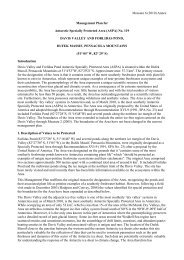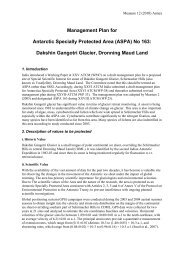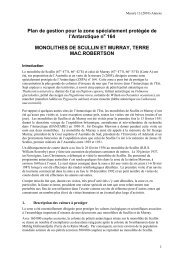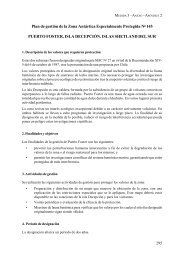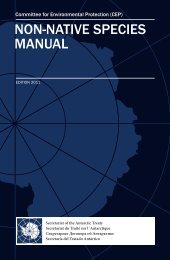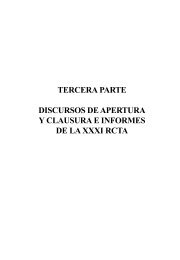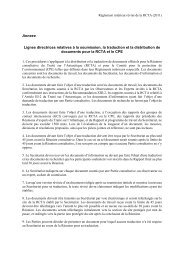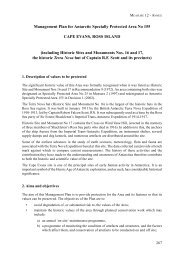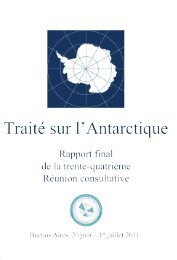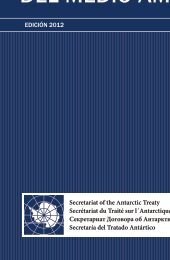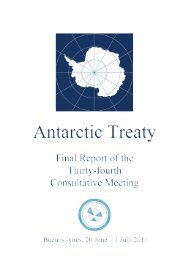Scott Base and McMurdo Station - Antarctic Treaty Secretariat
Scott Base and McMurdo Station - Antarctic Treaty Secretariat
Scott Base and McMurdo Station - Antarctic Treaty Secretariat
Create successful ePaper yourself
Turn your PDF publications into a flip-book with our unique Google optimized e-Paper software.
4. MCMURDO STATION (UNITED STATES OF AMERICA)4.1 GENERAL INFORMATIONThe inspection of <strong>McMurdo</strong> <strong>Station</strong> was undertaken on 23, 24 <strong>and</strong> 25 January 2005. No aerial observations of<strong>McMurdo</strong> <strong>Station</strong> were made.<strong>McMurdo</strong> <strong>Station</strong> is on Ross Isl<strong>and</strong> at 77ºº55’S, 166ºº39’E. The base acts as the hub of the United States<strong>Antarctic</strong> Program <strong>and</strong> was established to support the International Geophysical Year. The site has beencontinuously operated by the United States since the official opening of the base in 1958.Buildings have been erected over time as required <strong>and</strong> indicate a range of construction techniques. Some of themost recent buildings are the new scientific laboratories <strong>and</strong> the waste-water treatment plant. Several oldbuildings survive <strong>and</strong> there are now over 100 buildings. No buildings are currently under construction. The totalarea occupied by the station is some 400,000 m 2 <strong>and</strong> <strong>McMurdo</strong> <strong>Station</strong> is the largest permanent facility on the<strong>Antarctic</strong> continent.<strong>McMurdo</strong> <strong>Station</strong> supports scientific research at the station itself <strong>and</strong> in the immediate vicinity of Ross Isl<strong>and</strong>. Inaddition, a prime role of the station is to provide the prime entry point for United States activities in <strong>Antarctic</strong>a<strong>and</strong> to serve as a logistics hub to support scientific activities further afield throughout the Ross Sea region, theSouth Pole <strong>and</strong> other remote sites on the high plateau.Major research projects supported by the station include marine <strong>and</strong> terrestrial biology, biomedicine, geology,geophysics, glaciology, meteorology, aeronomy <strong>and</strong> atmospheric physics. <strong>McMurdo</strong> <strong>Station</strong> also supports visitsby media representatives <strong>and</strong> artists.There are several scientific facilities at <strong>McMurdo</strong> <strong>Station</strong>. The primary facility is the Crary Science Centre. Otherfacilities include an aquarium, ice core building, cosmic ray building, infrasound sensor station, seismic facilities,<strong>and</strong> gravity station.The station buildings are served by several formed roads which connect to the main feeder route to the nearby<strong>Scott</strong> <strong>Base</strong> (New Zeal<strong>and</strong>) <strong>and</strong> the ice shelf runways. An annual sea ice road connects to the sea ice runway inearly summer.In its role as a logistics hub the station supports three airfields: the annual sea ice runway, Williams Field ski way(South Pole flights <strong>and</strong> deep field sites), <strong>and</strong> Pegasus glacier ice runway (intercontinental flights from New Zeal<strong>and</strong>).There is an emergency l<strong>and</strong>ing area at Odell Glacier. Several helipads at <strong>McMurdo</strong> <strong>Station</strong> support local aviation.At the time of the inspection, overall responsibility for <strong>McMurdo</strong> <strong>Station</strong> fell to Mr Brian Stone, National ScienceFoundation (NSF) representative, <strong>and</strong> Mr Terry Melton, NSF <strong>Station</strong> Manager. Operation of the station iscontracted by the NSF to Raytheon Polar Services Company. Up to 1,100 people can be accommodated at thestation <strong>and</strong> 1,062 people were on station at the time of our visit. The majority of these people were Raytheonemployees, or military personnel engaged in logistic support for the scientific activities. A number of scientistsfrom United States <strong>and</strong> overseas institutions were on station at the time of our visit to conduct research or intransit to field sites. Around 200 people winter over at <strong>McMurdo</strong> station.4.2 OBSERVATIONS - ANTARCTIC TREATYUse of <strong>Antarctic</strong>a for peaceful purposes (Article I)The National Science Foundation operates a civilian scientific program. No military activities or armaments wereobserved at <strong>McMurdo</strong> <strong>Station</strong>. Various parts of the United States Department of Defense provide logisticssupport to the United States <strong>Antarctic</strong> Program. This includes the provision of air transport between NewZeal<strong>and</strong> <strong>and</strong> Ross Isl<strong>and</strong> (using Lockheed C141, C17 <strong>and</strong> C130 aircraft) <strong>and</strong> airlift to the South Pole <strong>and</strong> otherdeep field sites using LC130 aircraft. Military support is also provided for marine transport of dry cargo <strong>and</strong> fuel,cargo h<strong>and</strong>ling, navigational support <strong>and</strong> weather forecasting. The United States <strong>Antarctic</strong> Program participatesin a logistics pool arrangement with the New Zeal<strong>and</strong> <strong>and</strong> Italian programs which also use military personnel inthe logisitic support operations.Freedom of scientific investigation (Article II)There are multiple examples of the United States’ commitment to freedom of scientific investigation. <strong>McMurdo</strong><strong>Station</strong> <strong>Base</strong> has been occupied continuously since the International Geophysical Year.



